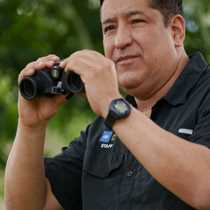We spent a full day exploring two remote locations of the reserve, Yanalpa Caño in the morning and “El Dorado River” in the afternoon.
We disembarked in direction to Belluda Caño at 6:30 am. Our goal was to explore the nearby shores of the Ucayali River where our ship was located. In a large section of this area in the vicinities of Belluda Caño there are many dead palm trees in a swampy area. These hollow palm trees are nesting and roosting places for Macaws. We were lucky for we observed several chesnut-fronted macaws coming out from the dead trees they inhabit. Several woodstorks were seen perching on high branches of trees along the river banks as well.
Once inside Belluda Caño we saw several colorful bird species including kingfishers, flycatchers and two monkey species. Squirrel monkeys and the fantastic noisy owl monkeys. The latter one is the only nocturnal monkey species in the world. These relatively unknown monkeys have a very interesting natural history and an uncertain taxonomic status as well. In the way back to the ship after a late breakfast I had the pleasure to give a talk on one of my favorite subjects, the morphology, ecology and behavior notes of the primates found in the Pacaya Samiria Reserve.
Before lunch naturalist Javier Arbildo had a fruit exhibition prepared for us. Our guest avidly tasted, tried, smelled and learnt about the many fruits found in this area of the world.
In the late afternoon, accompanied with a persistent tropical rain that helped to cool down a little the intense heat, we had plenty of time to go far and beyond El Dorado River. We experienced firsthand the extraordinary biodiversity that inhabit the rainforests and the sudden climate changes typical of this ecosystem. Despite of the constant rain our skilled naturalists handled to spot several bird species like horned screamers, wattled jacanas, some birds of prey and several three-toed sloths. As the day was ending and with the help of a powerful spotlight we found a three species of caiman alligators. We saw three juvenile spectacled, white and black caimans.
Late in the evening at around 1900 we finally made it back to the Delfin II after experiencing from the comfort of the skiffs a night ride in the way back. Despite of the constant rain we truly enjoyed this outing. This outing reminded us that we are in one of the wettest ecosystems on Earth.
After dinner our local crew’s band played some lively music. At the end of the day we went to bed with the wonderful feeling that we spent a great an peculiar day in one of the most intriguing and fascinating ecosystems Earth, the enigmatic Amazon.






